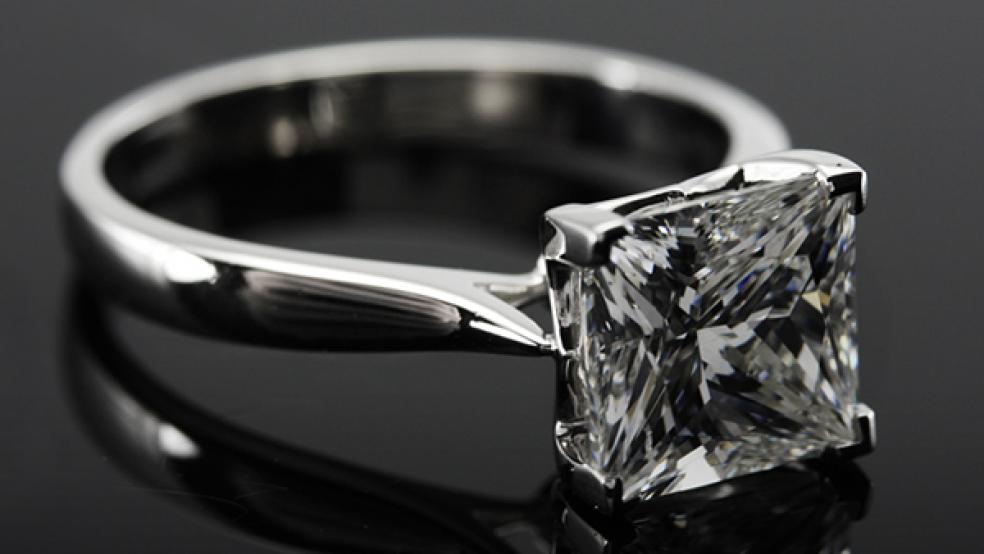Diamonds represent 41 percent of overall retail jewelry sales, but in recent years, moissanite has been gaining in popularity on the diamond, particularly in the engagement and wedding ring market.
Moissanite’s increasing popularity is largely due to the perception of it as an environmentally sustainable alternative to the diamond, while also being much more affordable (about one-tenth the price).
Chemist Henri Moissan was the first to study the gemstone in 1893, after it was originally recovered from a meteorite crater. Over the past century, scientists have worked to recreate and perfect the stone, and in 1998, it entered the jewelry market.
Moissanite is the second strongest gemstone on the planet--second only to the diamond--stronger than either the sapphire or ruby. And in terms of brilliance--that is, ability to reflect light or "sparkle"--moissanite is actually superior to the diamond.
Related: 7 Essential Tips for Buying a Cheap Wedding Dress...Without Getting Ripped Off
Virtually all moissanite stones available on the market are lab-created. This makes it a popular option for customers who have ethical concerns over the ecologically destructive mining practices often correlated to the diamond industry or objections to the exploitative human labor practices overseas. Furthermore, some consumers may not want to accidentally purchase a “blood diamond”--so-called because proceeds from mining of the sought-after gemstone has at times been used to fund violent military conflicts in some African nations.
Such concerns have been translating into more sales for moissanite.
Charles & Colvard, the manufacturer of the trademarked Forever Brilliant moissanite, had its best sales quarter last spring since 2006. Specifically, Charles & Colvard’s annual sales jumped 27 percent, outpacing the jewelry business average of 7.7 percent. The company’s fourth quarter last year saw sales rise 6 percent , yielding $8.6 million in revenue. Its direct-to-consumer businesses, which includes Moissanite.com and the home-sales channel Lulu Avenue, also increased 69 percent for that period to $1.3 million. Additionally, U.S. sales revenue for the nine months ended September 30, 2014 was $16.5 million, up 15% from the same period the previous year.
“When it comes to choosing engagement rings and other gems, today’s consumers are especially attuned to the balance between quality and value,” said Steve M. Larkin, Charles & Colvard’s chief operating officer. “This ‘quality versus value’ issue is also of interest to jewelry companies today, particularly in light of the challenging business climate reported over the just-ended holiday season—during which both Tiffany and Blue Nile missed their targets and had disappointing quarters.”
Related: The 25 Most Addictive Foods
Krish Himmatramka, founder of Do Amore, an online jewelry retailer that specializes in “ethically made” wedding rings, noted that moissanite rings comprise 45 percent of all of the company’s engagement ring sales, compared to only 25 percent for diamonds (a remaining 30 percent opted for sapphires).
Himmatramka believes affordability often makes the biggest difference in his customers’ general preference of moissanite over diamond.
“While affordability is key, even a customer that has the budget for a small diamond can purchase a larger stone if he or she opts for moissanite,” said Himmatramka. “There is also a sense of risk for some customers, who are concerned that if they purchase a diamond ring they will lose it. Moissanite seems like a less risky and therefore more attractive option.”
However, Himmatramka thinks environmental concerns factor into purchases as well.
Related: 15 of the Most Valuable Beanie Babies
“Some customers prefer the fact that moissanite was lab created in the U.S., making it one of the most environmentally friendly options there is,” says Himmatramka.
Meanwhile, some jewelry makers choose to work with moissanite primarily for this reason.
“Lab created stones like moissanite are easier on the environment and more traceable than mined stones, and since moissanite looks and performs like a diamond, I work a lot with this stone instead,” says independent jeweler Tamar McFarland of McFarland Designs, who does not work with diamonds.
McFarland at that her handmade moissanite rings, which are primarily available to order through her online Etsy shop, have been selling very well these past several years.
“Most of my customers find me because they are specifically looking for moissanite jewelry,” said McFarland. “Or, because they are looking for an ethically made engagement or wedding ring.”
Larkin agrees.
“Consumers are…increasingly interested in choosing gems that are conflict-free and have been sustainably sourced,” said Larkin. “If consumers don’t ‘feel good’ about a purchase, they are less likely to buy than ever before.”
This article originally appeared in MainStreet.
Read more from MainStreet:
How to Find a New Job Without Getting Fired from Your Current One
7 Reasons Millennials Are Turning to Credit Unions Instead of Banks
Top 10 Robo Advisors Ranked: Find the Best Automated Online Investing Services

